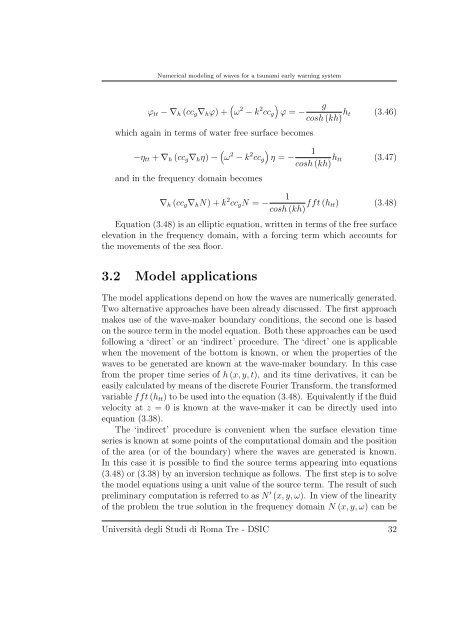Numerical modeling of waves for a tsunami early warning system
Numerical modeling of waves for a tsunami early warning system
Numerical modeling of waves for a tsunami early warning system
Create successful ePaper yourself
Turn your PDF publications into a flip-book with our unique Google optimized e-Paper software.
<strong>Numerical</strong> <strong>modeling</strong> <strong>of</strong> <strong>waves</strong> <strong>for</strong> a <strong>tsunami</strong> <strong>early</strong> <strong>warning</strong> <strong>system</strong><br />
ϕtt −∇h (ccg∇hϕ)+ <br />
ω 2 − k 2 g<br />
ccg ϕ = −<br />
cosh (kh) ht<br />
which again in terms <strong>of</strong> water free surface becomes<br />
−ηtt + ∇h (ccg∇hη) − <br />
ω 2 − k 2 1<br />
ccg η = −<br />
cosh (kh) htt<br />
and in the frequency domain becomes<br />
(3.46)<br />
(3.47)<br />
∇h (ccg∇hN)+k 2 1<br />
ccgN = −<br />
cosh (kh) fft(htt) (3.48)<br />
Equation (3.48) is an elliptic equation, written in terms <strong>of</strong> the free surface<br />
elevation in the frequency domain, with a <strong>for</strong>cing term which accounts <strong>for</strong><br />
the movements <strong>of</strong> the sea floor.<br />
3.2 Model applications<br />
The model applications depend on how the <strong>waves</strong> are numerically generated.<br />
Two alternative approaches have been already discussed. The first approach<br />
makes use <strong>of</strong> the wave-maker boundary conditions, the second one is based<br />
on the source term in the model equation. Both these approaches can be used<br />
following a ‘direct’ or an ‘indirect’ procedure. The ‘direct’ one is applicable<br />
when the movement <strong>of</strong> the bottom is known, or when the properties <strong>of</strong> the<br />
<strong>waves</strong> to be generated are known at the wave-maker boundary. In this case<br />
from the proper time series <strong>of</strong> h (x, y, t), and its time derivatives, it can be<br />
easily calculated by means <strong>of</strong> the discrete Fourier Trans<strong>for</strong>m, the trans<strong>for</strong>med<br />
variable fft(htt) to be used into the equation (3.48). Equivalently if the fluid<br />
velocity at z = 0 is known at the wave-maker it can be directly used into<br />
equation (3.38).<br />
The ‘indirect’ procedure is convenient when the surface elevation time<br />
series is known at some points <strong>of</strong> the computational domain and the position<br />
<strong>of</strong> the area (or <strong>of</strong> the boundary) where the <strong>waves</strong> are generated is known.<br />
In this case it is possible to find the source terms appearing into equations<br />
(3.48) or (3.38) by an inversion technique as follows. The first step is to solve<br />
the model equations using a unit value <strong>of</strong> the source term. The result <strong>of</strong> such<br />
preliminary computation is referred to as N ′ (x, y, ω). In view <strong>of</strong> the linearity<br />
<strong>of</strong> the problem the true solution in the frequency domain N (x, y, ω) canbe<br />
Università degli Studi di Roma Tre - DSIC 32

















